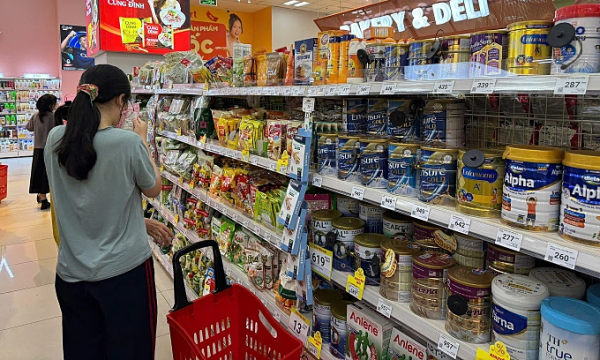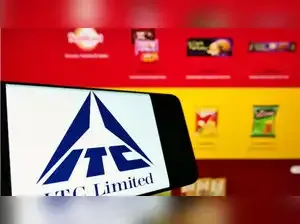
In early April the 60-year-old in Hanoi went for a check-up after experiencing persistent joint pain that did not improve even though she had been taking several types of supplements daily.
When she was diagnosed with joint degeneration, osteoporosis and herniated discs, she was shocked. The doctor told her one of the supplements she had been taking contained corticosteroids, a strong anti-inflammatory drug that can weaken bones and lead to adrenal insufficiency.
At home, Thuy asked her child to research, and they found out that many of the products she had been using were declared counterfeits by authorities. “I thought expensive medicines were good, but it turns out I have been buying fakes,” she says.
A month later she found that another product she had been consuming, advertised as helping “prevent osteoporosis,” was part of a large-scale fake milk powder operation. “At this point I suspect everything I have bought over the last five years is fake,” she says.
|
A customer carefully checks a product label at a supermarket in Thanh Xuan District, Hanoi, on June 9, 2025. Photo by Read/Nga Thanh |
Since April authorities have uncovered a number of major counterfeit operations, including a fake medicine production gang in the central Thanh Hoa Province, fake electronic goods worth VND22 billion (US$842,270) at a warehouse in Hanoi, and a counterfeit milk powder operation that generated nearly VND500 billion in revenues.
On June 7 a network producing counterfeit motor oils of brands like Castrol, Motul and Honda was shut down in HCMC. Two days later a company in the central Phu Yen Province was accused of selling 17 tons of fake coffee.
In the first quarter of 2025 market management authorities carried out 6,192 raids and found over 5,600 cases of counterfeit, smuggled or substandard goods.
Thanh Truc, 29, of HCMC’s Binh Tan District discovered that her hometown in Nghe An Province was “full of fake products” when visiting her parents. She noticed that their toothpaste was clumpy and had an odd taste, a bottle of body wash and shampoo from a famous brand they used did not lather and caused itching and a packet of MSG had uneven grains and a cloudy appearance.
Upon closer inspection Truc realized that the shampoo labeled “Clean” was actually meant to mislead consumers who might be looking for the well-known “Clear” brand.
“These counterfeit products might not harm immediately, but over time, I cannot imagine the consequences,” Truc says.
Many people are as confused as Thuy and Truc, especially with the growing discoveries of large-scale counterfeit production.
Vu Van Trung, vice president of the Vietnam Consumer Protection Association, points out that online platforms are becoming prime places for selling fake goods.
“The tactics used by counterfeiters are getting more sophisticated, and they are taking advantage of loopholes in e-commerce regulations, particularly through live-streamed sales on social media.”
These platforms are easy to create, difficult to monitor and easy to erase after selling fake goods, he says.
According to him, the massive profits from counterfeits are a major driving force, he says.
Nguyen Truong Son, president of the Vietnam Advertising Association, notes that profits can reach billions of dong while fines for selling fakes are only VND20-80 million, hardly enough to deter criminals.
A 2021 survey by the Market Surveillance Agency found that 80% of consumers knowingly buy fake goods because of their low prices or a desire to own branded products they cannot afford.
In April Hai Long, 45, of Hai Phong was hospitalized with seizures triggered by taking pills from a pack of “imported stroke prevention” medicine that cost VND1 million for 10 pills.
It was only after being hospitalized and told by the doctor that he stopped taking the pills. A month later the product was revealed to be counterfeit, shocking his entire family.
After that his wife, Minh Ha, refused all further recommendations for foreign drugs or supplements. She has switched back to using homemade pork fat, ordering rice and fish sauce from her hometown and growing vegetables on their rooftop. Her trips to the supermarket now take three to four times longer, as she carefully reads labels and scans QR codes on every product.
Ha says: “Living in a maze of real and fake goods, from vegetables to fish sauce and pills, I can no longer tell them apart. Now I have to protect my family on my own.”
After discovering she had been using counterfeit supplements, Thuy discarded all the products and now endures daily pain while awaiting treatment. When the pain becomes unbearable, she asks to be taken to the hospital and follows the treatment prescribed by her doctor.
Meanwhile, her daughter Do Quyen, 25, has decided to confront the issue: she now spends time researching product information, checking codes, watching instructional videos on distinguishing genuine products from fakes, and teaching her family members.
This growing desire for self-protection has sparked a new trend on social media, with posts and videos offering guidance on how to distinguish between real and fake products through codes, labels and product structure attracting huge interest.
Given the current situation, experts advise consumers to be more proactive. Professor Nguyen Duy Thinh, a former lecturer at the Hanoi University of Science and Technology, recommends prioritizing purchases from authorized stores, supermarkets, and reputable pharmacies.
“Be cautious of unusually cheap products, and do not trust groundless tips for distinguishing real from fake that circulate online,” Thinh cautions.
Trung says consumers should not just stop using suspected fakes but also report them immediately to authorities.
“Each individual’s action not only protects themselves but also helps protect the community,” he says.
-
R Praggnanandhaa wins UzChess Cup Masters, becomes top-ranked Indian and World No.4

-
ITC says consumer spending rises 4.6 pc to Rs 34,000 cr in FY25, launches 100 new FMCG products

-
Approach to treat act of terror as act of war added new dimension to operational outlook: Navy chief

-
India first team to lose Test match despite scoring five centuries

-
All hypotheses on Covid-19 origins 'remain on the table': WHO chief
